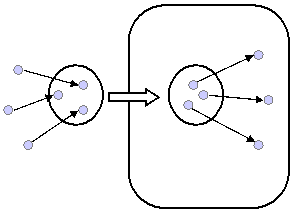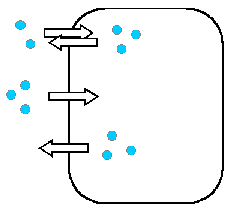Membrane Computing
 Gheorghe Păun:
Membrane Computing,
an introduction.
Gheorghe Păun:
Membrane Computing,
an introduction.
Natural Computing Series, Springer, 2002.
ISBN: 3-540-43601-4
 Pierluigi Frisco:
Computing with Cells: Advances in Membrane Computing.
Pierluigi Frisco:
Computing with Cells: Advances in Membrane Computing.
OUP, 2009
ISBN: 0199542864
(Based on DLT'02 and WMC'02)
H.J. Hoogeboom
presentation (pdf)
(seminar Models of Computation, Utrecht, 2012)
too much slides, includes Petri Nets under maximal strategy
P systems web page (Milano)
VIEWS project (Leiden 2004-2009)
Three Leiden PhD students presented a thesis (partially) in membrane computing.
Pierluigi Frisco. Theory of Molecular Programming — Splicing and Membrane systems. Ph.D. Thesis, Universiteit Leiden, May 2004.
Robert Brijder. Models of Natural Computation: Gene Assembly and Membrane Systems. Ph.D. Thesis, Universiteit Leiden, december 2008. repository
Jun Wang 汪隽. Spiking Neural P Systems. Ph.D. Thesis, Universiteit Leiden, december 2011. repository / papers
Thís page is devoted to inert (non-reactive) P systems, where computation is performed by communication, and by moving objects around the system. Simple and elegant.
P systems with Carriers

Introduced in: C. Martín-Vide, Gh. Păun, G. Rozenberg, Membrane Systems with Carriers, Theoretical Computer Science 270 (2002) 779-796. »
rules (associated to region) for multiset x carrier v:
attach: vx → [vx]
detach: [vx] → vx
carry in: [vx] → in
'move into a membrane within the present region'
carry out: [vx] → out
Carriers and Counters: P systems with Carriers vs. (Partially Blind) Counter Automata.
In: M. Ito and M. Toyama (Eds.) Developments in Language Theory, 6th International Conference, DLT 2002, Kyoto, Japan, September 18-21, 2002, Revised Papers. pages 140-151. Lecture Notes in Computer Science 2450, Springer Verlag 2003.
abstract: P systems with carriers are shown to be computationally complete with only one membrane and two carriers. We argue that their power is due to the maximal parallelism required in the application of the rules. In fact, with a single carrier, these systems are equivalent to partially blind counter automata. Finally, with a single passenger restriction the systems are again computationally complete.
nb. partially was added to be slightly more in line with usual terminology!
N·CPm(c,p), where the parameters represent the number of membranes, carriers, and passengers per carrier, respectively.
Theorem 1.
N·RE = N·CP1(2,3)
Corollary 4.
N·BC
= N·CP*(1,*)
= N·CP1(1,3)
Theorem 5.
N·RE = N·CP*(*,1)
P Systems with Single Passenger Carriers.
International Journal of Foundations of Computer Science 17 (2007) 1227-1235.
doi:10.1142/S0129054107005273
abstract: Membrane systems with carriers holding only a single passenger are known to be computationally complete, although this result does not bound the number of membranes and the number of carriers. We show that actually two membranes suffice.
Theorem 2. N·RE = N·CP2(*,1)
P systems with Symport/Antiport

Introduced in: A. Păun, Gh. Păun. The Power of Communication: P Systems with Symport/Antiport. New Generation Computing, 20 (2002), pages 295-305.
rules (associated to membrane) for multisets x,y:
symport: (x,in),
(x,out)
antiport: (x,in;y,out)
Simulating counter automata by P systems with symport/antiport.
In: Membrane Computing: International Workshop, WMC-CdeA 2002, Curtea de Argeş, Romania, August 19-23, 2002. Revised Papers. Lecture Notes in Computer Science 2597, Springer Verlag 2003.
abstract: The complexity, expressed in number of membranes and weight of rules, of P systems with symport/antiport generating recursively enumerable sets is reduced if counter automata instead of matrix grammars are simulated. We consider both subsets of N obtained by counting objects in a designated membrane, and string languages obtained by following the traces of a designated object.
P systems with Symport/Antiport
Theorem 3.
N·RE = N·PP1(sym1,anti2)
Theorem 5.
N·RE = N·PP2(sym3,anti0)
A single membrane suffices with 13 additional symbols in the output membrane.
Theorem 9.
N·RE = N·PP4(sym2,anti0)
Following the Traces
ℓ is the size of the alphabet.
Theorem 11.
ℓ·RE = ℓ·PPℓ+1(sym0,anti2)
= ℓ·PPℓ+1(sym3,anti0)
= ℓ·PPℓ+2(sym2,anti0)
Numbering of results as in the full paper:
P. Frisco, H.J. Hoogeboom,
P systems with symport/antiport simulating counter automata.
Acta Informatica 41 (2004) 145-170.
doi: 10.1007/s00236-004-0154-y
28.10'04
4.1'06